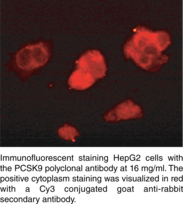| References |
| Synonyms |
- Proprotein Convertase Subtilisin Kexin 9
- NARC-1
|
| Formulation |
200 µg IgG lyophilized from TBS, pH 7.4 |
| Stability |
1 year |
| Storage |
-20°C |
| Shipping |
Wet ice
in continental US; may vary elsewhere
|
| Specificity |
| Human PCSK9 |
+ |
| Murine PCSK9 |
+ |
| Rat PCSK9 |
+ |
|
Background Reading
Benjannet, S., Rhainds, D., Essalmani, R., et al. NARC-1/PCSK9 and its natural mutants. Zymogen cleavage and effects on the low density lipoprotein (LDL) receptor and LDL cholesterol. J Biol Chem 279(47) 48865-48875 (2004).
Seidah, N.G., Benjannet, S., Wickham, L., et al. The secretory proprotein convertase neural apoptosis-regulated convertase 1 (NARC-1): Liver regeneration and neuronal differentiation. Proc Natl Acad Sci USA 100(3) 928-933 (2003).
| Size |
Global Purchasing |
| 500 µl |
|
Description
Antigen:
synthetic peptide from human PCSK9 amino acids 490-502 (SRSGKRRGERMEA)
·
Host:
rabbit
·
Application(s):
WB and ICC; other applications not tested
·
Proprotein convertase subtilisin kexin 9 (PCSK9) is a member of the subtilisin serine protease family with an important role in lipoprotein metabolism.1 Mutation in the PCSK9 gene is associated with autosomal dominant hypercholesterolemia which is characterized by an increase in low density lipoprotein (LDL) cholesterol levels.2 PCSK9 overexpression in wild-type mice doubles the plasma total cholesterol, possibly through acceleration of the degradation of the LDL receptor.3,1 PCSK9 mRNA is detected in various tissues such as liver, kidney, lung, spleen, jejunum, ileum, colon, and muscle with the highest expression in the liver.4 Human PCSK9 precursor is 692 amino acid in length with an estimated molecular weight of 74 kDa. This proprotein is self-cleaved to form a mature protein at around 63 kDa in the golgi.5 Cayman’s PCSK9 polyclonal antibody detects mainly the mature form of the protein ranging from 62-66 kDa in tissues and cells such as liver, kidney, and colon cancer cells.
1
Maxwell, K.N., Fisher, E.A., and Breslow, J.L. Overexpression of PCSK9 accelerates the degradation of the LDLR in a post-endoplasmic reticulum compartment. Proc Natl Acad Sci USA 102(6) 2069-2074 (2005).
2
Abifadel, M., Varret, M., Rabès, J., et al. Mutations in PCSK9 cause autosomal dominant hypercholesterolemia. Nat Genet 34(2) 154-156 (2003).
3
Maxwell, K.N., and Breslow, J.L. Adenoviral-mediated expression of Pcsk9 in mice results in a low-density lipoprotein receptor knockout phenotype. Proc Natl Acad Sci USA 101(18) 7100-7105 (2004).
4
Seidah, N.G., Benjannet, S., Wickham, L., et al. The secretory proprotein convertase neural apoptosis-regulated convertase 1 (NARC-1): Liver regeneration and neuronal differentiation. Proc Natl Acad Sci USA 100(3) 928-933 (2003).
5
Maxwell, K.N., and Breslow, J.L. Proprotein convertase subtilisin kexin 9: The third locus implicated in autosomal dominant hypercholesterolemia. Curr Opin Lipidol 16 167-172 (2005).
|






